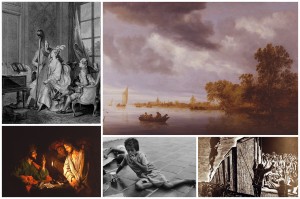
Dichotomies are essential parts of human life. For this reason, humans often define relationships, whether personal, social, or political, in terms of unity and division. Because art is ultimately a tangible expression of humanity, it is essential to seek aspects of unity and disunity within it.
As an investigation of the coexistence of harmony and discord, this exhibition of pieces from the Ackland Art Museum explores how the threshold between unity and disunity is manifested in the forms of competition, suffering, and betrayal.
Joselin and Deportation to Death (Death Train) reveal the (dis)unity of suffering. In the former are victims of poverty and in the latter are victims of anti-Semitism, and in each, the victims are alienated from the rest of society while ultimately forming bonds with those that they suffer with. L’accord Parfait (Perfect Harmony) and River Landscape with Fishermen reveal the (dis)unity of competition, as both depict the scenario of two competing parties that form a temporary union in order for each to get closer to a mutual goal. Finally, Christ Before Caiaphas, which depicts the trial between Christ and high priest Caiaphas, uses the manipulation of light and human features in order to comment on the transition from unity to disunity in the form of betrayal. L’accord Parfait also comments on the dis(unity) of betrayal by portraying how infidelity shatters the illusion of union within marriage.
Though these pieces themselves are divided in medium, category, and historical background, they are united in theme. Even suffering, competition, and betrayal – concepts that are typically viewed in a negative light due to the disunity that is evident within them – show aspects of unity. The purpose of this exhibition is thus to show how the interplay of unity and disunity, no matter how or where it manifests itself, is timeless, universal, and integral to human identity.
Danny Lyon, Joselin, Santa Marta, Colombia, 1972
Leopoldo Méndez, Deportation to Death (Death Train), 1942
Salomon van Ruysdael, River Landscape with Fisherman, 1643
Unidentified Artist, Perfect Harmony (L’accord parfait), 1777
Matthias Stom, Christ Before Caiaphas, 1630s